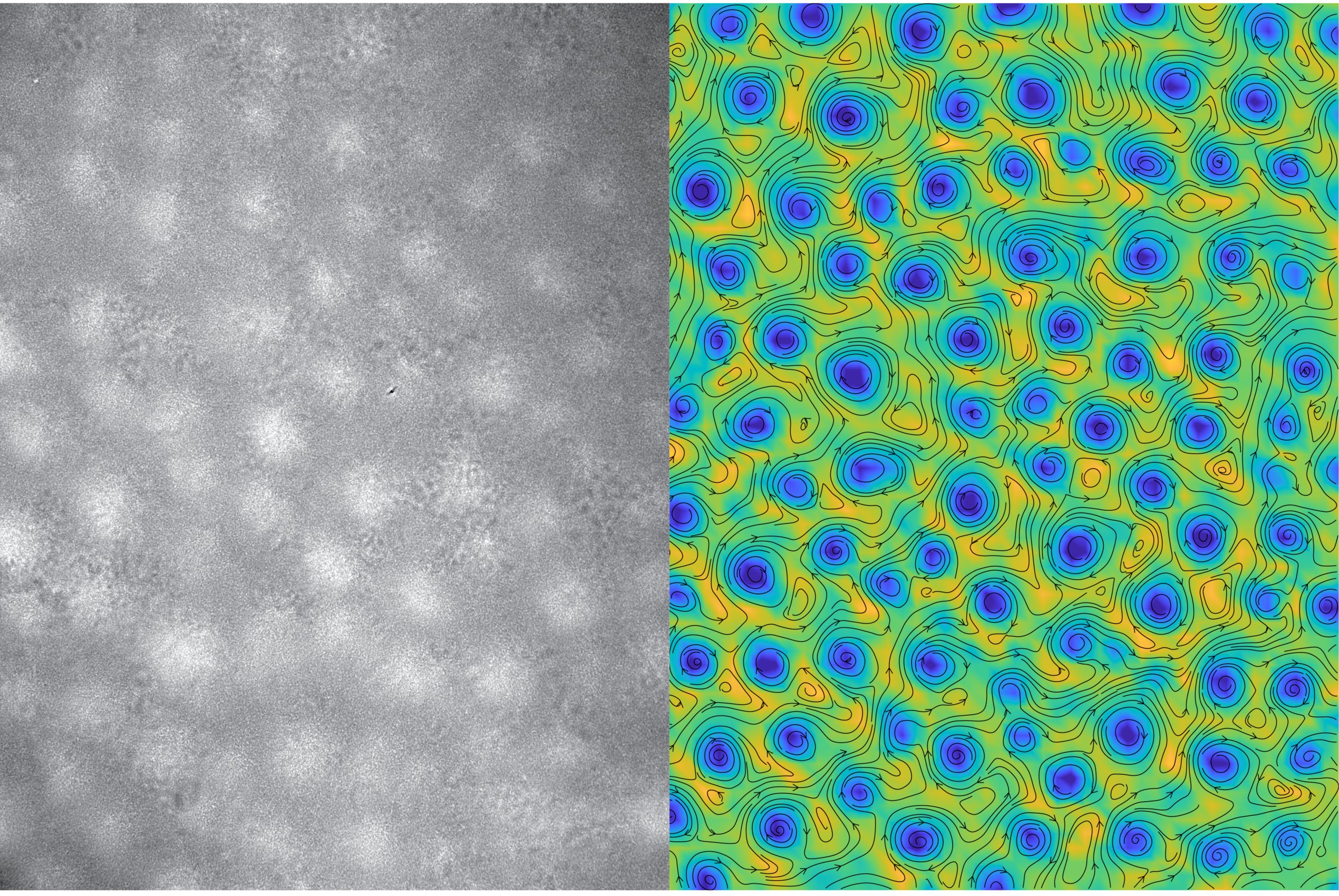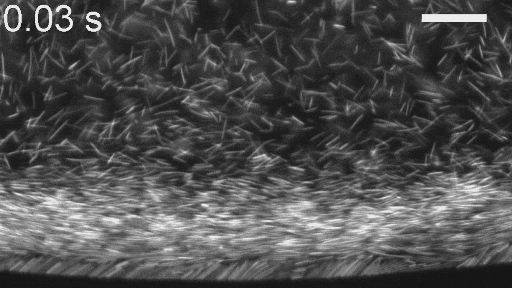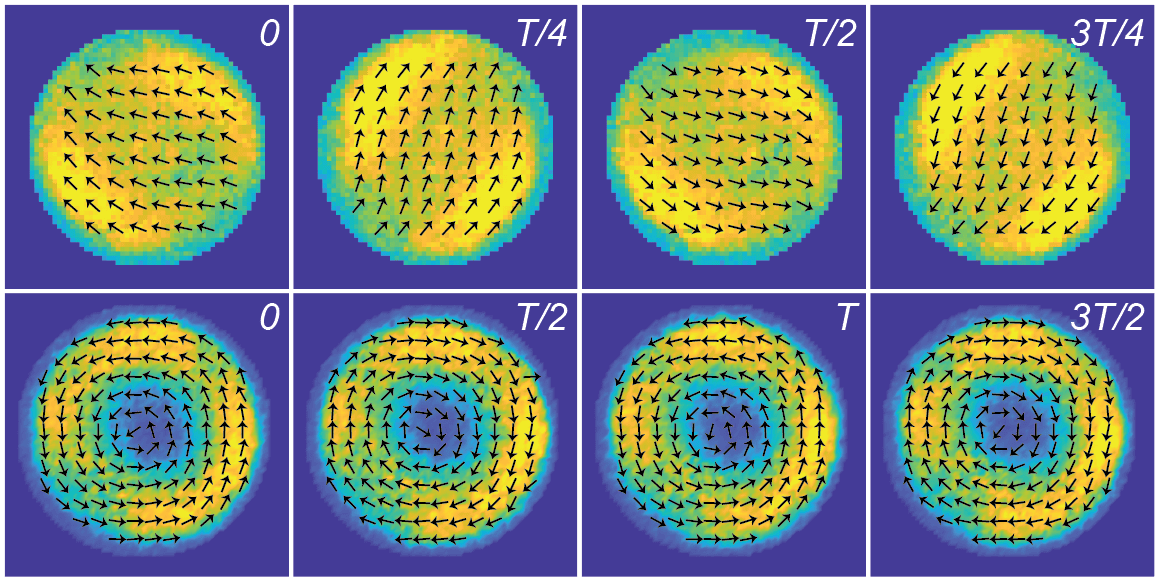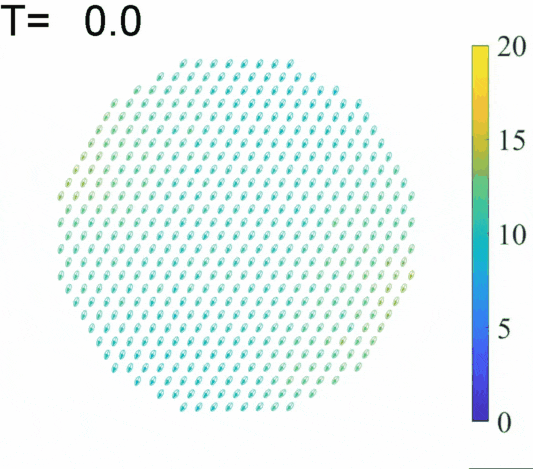Research projects:
- Self-organization and pattern formation in living active matter
- Autonomous motion in living active solids and nematics
- Mechanical/chemical signaling in living systems
- Numerical simulations of active matter
1. Self-organization and pattern formation in living active matter
-
Vortex lattice patterning in dense bacterial suspensions

The emergence of ordered spatial patterns in biology is often driven by intricate chemical signalling that coordinates cellular behaviour and differentiation. Here we discovered a new route to self-organized pattern formation driven by physical interactions, which creates large-scale regular spatial structures with multiscale ordering. Our findings demonstrate that self-enhanced mobility offers a simple physical mechanism for pattern formation in living systems and, more generally, in other active matter systems near the boundary of fluid- and solid-like behaviours. See [Movie 1], [Movie 2], [Movie 3].
References:
- Haoran Xu, Yilin Wu (2024) Self-enhanced mobility enables vortex pattern formation in living active matter. Nature. 627,553-558.
-
Bacteria self-organize to drive material transport in colonies

Bacteria normally rely on diffusion for material transport, such as nutrient uptake or signal exchange. Diffusion is slow if the distance is long. An interesting question is, can bacteria make use of the flagellum-driven flows for long-distance transport? Here we show that flagellated bacteria in colonies can achieve this goal via self-organization. This new mechanism of long-range active transport may bring profound effect on the physiology of bacterial communities in structured environments with heterogeneous nutrient distribution, such as those commonly found in natural and clinical settings. See [Movie 1], [Movie 2], [Movie 3].
References:
- Haoran Xu, Justas Dauparas, Debasish Das, Eric Lauga, Yilin Wu (2019) Self-organization of swimmers drives long-range fluid transport in bacterial colonies. Nature Communications. 10, 1792.
-
Active matter invasion and morphogenesis

Biological active matter consisting of living cells often invades the surrounding space via activity-induced boundary deformation or interface growth. Here, we describe a unique mode of invasion and pattern formation in bacterial active matter. In this mode, active drops of bacterial suspensions develop regularly spaced interfacial protrusions at the edge; the protrusions further transform into creeping branches in a hierarchical, self-similar manner, with the transition probability depending on the interface geometry (local curvature). Our findings show that interface geometry may play important roles in active matter morphogenesis and suggest a strategy to manipulate pattern formation in active materials. See [Movie 1], [Movie 2],
References:
- Haoran Xu, Mehrana R Nejad, Julia Mary Yeomans, Yilin Wu (2023) Geometrical control of interface patterning underlies active matter invasion. PNAS. 120.30:e2219708120
2. Autonomous motion in living active solids and active nematics
-
Bacterial active solids

Elastic active matter—also called an active solid—consists of self-propelled units embedded in an elastic matrix and it resists deformation. This shape-preserving property and the intrinsic non-equilibrium nature make active solids an attractive potential component for self-driven devices, but their mechanical properties and emergent behaviour remain poorly understood. Here, using a biofilm-based living active solid, we observe self-sustained elastic waves with wave properties not seen in passive solids, such as power-law scaling of wave speed with activity. Under isotropic confinement, the active solid develops two topologically distinct global motion modes that can be selectively excited, with a step-like frequency jump at the transition between the two modes. Our findings reveal spatiotemporal order in elastic active matter and may guide the development of solid-state adaptive or living materials. See [Movie 1], [Movie 2], [Movie 3],
References:
- Haoran Xu, Yulu Huang, Rui Zhang, Yilin Wu (2023) Autonomous waves and global motion modes in living active solids. Nature Physics. 19,46–51
4. Numerical simulations of active matter
-
Partial differential equation modelling vortex lattice in active fluids

We adopted the framework of a minimal continuum model based on the seminal Toner–Tu active fluids model and a Swift–Hohenberg-type fourth-order term that successfully describes active turbulence in dense bacterial suspensions. A new key ingredient in our model is that, to account for the behaviour of self-enhanced mobility, effective viscosity entering the model parameters is taken as being dependent on local polar order. See [Movie 1], [Movie 2], [Movie 3].
References:
- Haoran Xu, Yilin Wu (2024) Self-enhanced mobility enables vortex pattern formation in living active matter. Nature. 627,553-558.
-
Langevin equation modelling active solids


We performed numerical modelling of active solids using a particle-based model by considering a collective of overdamped self-propelled particles connected by Hookean springs and initially arranged in a 2D triangular lattice. Each particle represents a mass element consisting of ~1,000 cells and has an intrinsic self-propulsion polarity, which accommodates the emergent self-propelled motion of the mass element driven by the propulsive forces of motile cells embedded in the mass element. See [Movie 1], [Movie 2],
References:
- Haoran Xu, Yulu Huang, Rui Zhang, Yilin Wu (2023) Autonomous waves and global motion modes in living active solids. Nature Physics. 19,46–51